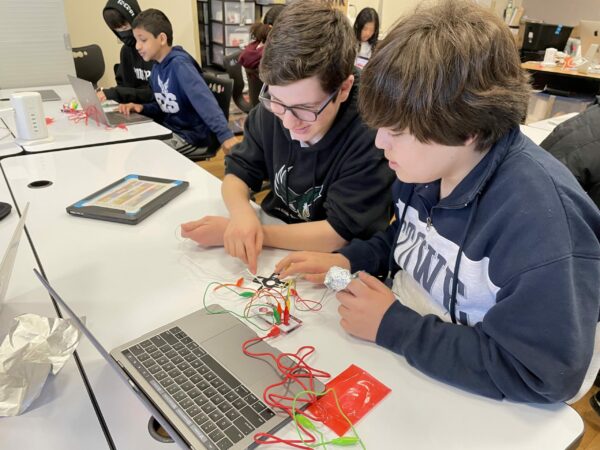Coding kits ignite curiosity and nurture creativity
By Laura Adams Stiansen; originally published in the Summer 2022 edition of “Apple Tree Magazine”
At The Elisabeth Morrow School, technology is woven into all subject areas and across all three divisions, as appropriate for each age group, to augment learning and allow students to create, design, and access information in new ways.
As the next generation of leaders, designers, and builders, our students must understand how digital and physical objects interact in our world to help build effective problem-solving skills, develop creativity, and prepare them for success now and in the future. One of the many ways our students do this is by building their skills in computer science and strengthening their invention literacy.
“Being invention literate means being able to look at the world around you, think about how things work, and imagine how they might work differently,” says Jay Silver, the co-creator of Makey Makey, an invention kit for the 21st century that helps students develop the ability to “read and write” (understand and create) human-made stuff. “When students put on the hat of an inventor, they can read the world in new ways and feel confident about how they could re-invent it. Students can hone their invention literary skills by researching, tinkering, and creating their own inventions.”
One example of this took place this spring when our seventh-grade students explored physical computing with Makey Makey in computer science class. “Ma-Key” stands for “Make their own Keyboards” and the Makey Makey kit consists of a circuit board that connects to a computer via a USB cable and allows the circuits to be used as a keyboard. Each metal pad on the circuit board is a conductive touchpad and works when connected to other objects that conduct electricity. The students designed and constructed the objects that interacted with their code to create maze, trivia, and interactive story games that used a controller with arrow keys and a spacebar.
“Using the design process and engineering skills, they generated ideas, built and tested models, and created solutions to important problems,” says Morrow House Technology Integrator Samantha Morra.
Students also accessed a variety of coding tools, including Scratch, a free programming language and online community created by the MIT Media Lab, to help them create their own interactive stories, animations, and more for their games.
“Electronic devices, such as Makey Makey, provide Scratchers with the opportunity to consider how humans express themselves physically. Makey Makey allows you to take everyday objects and combine them with Scratch projects to explore computational thinking concepts and practices and perspectives,” says Francisco Cervantes, Director of Creative Learning at Scratch Foundation. “We find that teachers use Makey Makey in science classrooms to provide students with a great hands-on introduction to electric circuits and engineering design. Micro-controllers when paired with creative learning activities can guide students through the learning process of developing computational thinking skills; analyzing computer applications around them based on a meaningful issue; prototyping a project that reflects the result of the analysis plus their passions; and communicating about their projects.”
Students worked individually on the games that they designed, but then collaborated with other students to obtain feedback on how to modify and refine their games, and design a controller. “This helps them understand the importance of feedback as they design and create,” says Morra.
To explore physical computing, EMS students also use small robotics and circuitry tools to make connections between their code and the physical world, including creating bubble ma-chines, moving sculptures, robots, “Iron Man” armor, and more. There are many physical devices that Morrow House students use to support their learning programming, including Makey Makey, Sphero, Cubelets, Ozobot, and Micro:bit, Raspberry Pi and Arduino, which are more advanced.
“Our computer science class is often about asking good questions,” says Morra. “As students create for the digital world with coding, we need to empower them with the tools to fully explore how what they create can impact the world. These tools often involve an understanding of electricity and engineering. With physical computing, we give students the opportunity to ask hard questions, envision solutions, and then give them the tools to make their vision a reality.”
There's No Better Time to Support Your Child's Education
Every time you donate to one of Elisabeth Morrow's dedicated funds, you help enrich the daily experiences of our community on campus. STEAM spaces are improved, library catalogues expanded, scholarships are funded, and teachers are hired. Every day, you can see the impact your generous donations have on campus.


